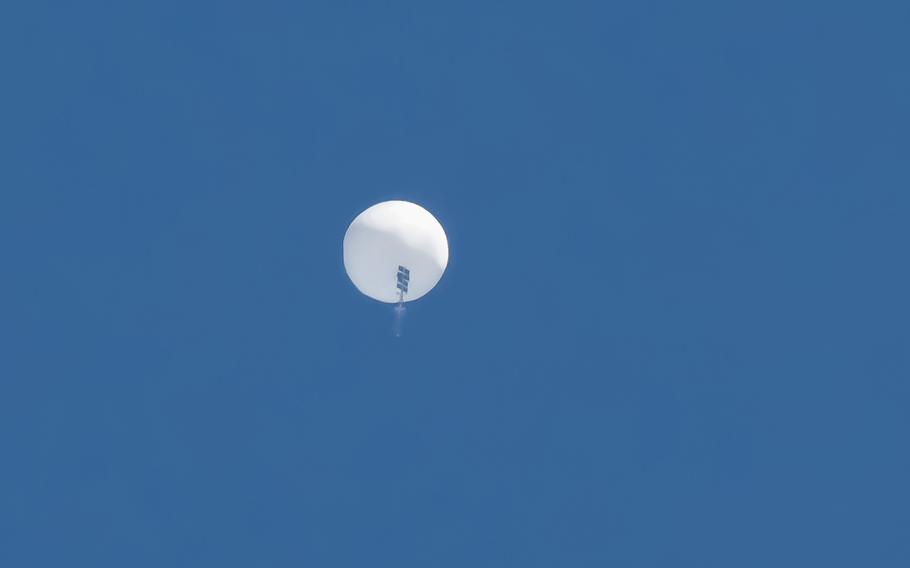
A Chinese spy balloon shortly before it was shot down over Surfside Beach, S.C., on Saturday, Feb. 4, 2023. (Joe Granita, Zuma Press/TNS)
WASHINGTON — Crews are searching a debris field off the East Coast to recover parts of the Chinese balloon shot down by an American fighter jet after U.S. officials accused the aircraft of spying as it crossed high above the United States, the top general for the North American Aerospace Defense Command said Monday.
Air Force Gen. Glen VanHerck told reporters at the Pentagon that the size of the debris field is estimated to be 1,500 meters by 1,500 meters in about 50 feet of water off the South Carolina coast.
“So, more than 15 football fields by 15 football fields,” VanHerck said of the debris field, adding the military, FBI and local law enforcement have secured the debris field and are participating in the search.
Navy and Coast Guard vessels were operating in the debris field on Monday, VanHerck said, which included dispatching divers and cranes. He also said he expects a more detailed map of the field to be produced shortly, which will give them a better idea where to look for remnants. VanHerck said crews are using side-scan sonar and other underwater technologies to map out the debris.
The balloon traversed the United States from an area near Alaska south into the northwestern U.S. and across the country to the mid-Atlantic region for several days last week before President Joe Biden on Wednesday ordered it to be shot down when it was safely over the water. An F-22 Raptor fighter jet from Joint Base Langley-Eustis in Hampton, Va., shot down the balloon Saturday.
Pentagon officials have said they didn’t immediately shoot down the balloon when it was first detected out of concern that such a large debris field could hurt people or damage property on the ground. VanHerck said Monday that one of the concerns was the balloon might be carrying explosives, possibly to blow itself up if necessary.
He described the balloon as up to 200 feet tall with payload similar in size to one for a jet airliner and weighing more than a couple thousand pounds.
“Picture yourself with large debris weighing hundreds if not thousands of pounds falling out of the sky,” VanHerck said. “Glass off of the solar panels, possibly hazardous material such as materials as required for batteries to operate in an environment such as this, and even the potential for explosives to detonate and destroy the balloon that could have been present.”
He urged the public to avoid handling any of the debris if it washes up on shore, and instead contact the FBI or local law enforcement.
“We expect [search crews] to do some additional categorization of potential threats, such as explosives that may be on it,” VanHerck said, noting no evidence of explosives has yet been found. “We are working very hard.”
The general declined to disclose further details about other aspects of the balloon, saying he didn’t want to get ahead of information that he expects to give to Congress soon.
From the beginning, the Pentagon said it suspected the balloon was conducting surveillance operations for the Chinese government. Beijing has claimed the balloon was not spying, but rather it was conducting scientific activities — a claim U.S. officials rejected.
Iain Boyd, a professor of aerospace engineering sciences and the director of the Center for National Security Initiatives at the University of Colorado, said it’s certainly not a weather balloon, but it also might not be a spy balloon.
“It could just be China poking the U.S. in the eye a little bit and causing quite a stir over here,” Boyd said. “This is a big story and a lot of people are spending a lot of time talking about it, thinking about it. China has complained for many years about the U.S. spying on them. And maybe this is a way for China to say, 'Look, we can reach out and cause you aggravation, too.’”
The incident has thrown a wrench into what are already strained U.S.-Chinese relations and even led Secretary of State Antony Blinken to postpone a trip to China that was scheduled to happen this week.
U.S. military officials have also said in recent days that this isn’t the first time a Chinese balloon has gotten near American airspace. They said there were at least four previous sightings — three when former President Donald Trump was in office and one additional instance under Biden. VanHerck said none of the previous sightings were detected by NORAD, which he considered an “awareness gap.”
“That’s a domain awareness gap that we have to figure out,” he said. “But I don’t want to go into further detail.”
On Sunday, the Pentagon notified lawmakers in Congress about the previous sightings of Chinese balloons, The Washington Post reported. According to the report, those balloons were spotted near Florida, Texas, Hawaii and Guam. It wasn’t noted, however, whether any of those balloons made it into U.S. airspace.
(Noga Ami-rav/Stars and Stripes)